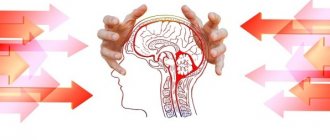In modern psychiatric science, there are many different human mental disorders.
These include reactive psychosis. This concept includes completely different behavioral disorders, worldviews and other disorders caused by serious stressful situations. A distinctive feature of the described type of psychosis is that along with the disappearance of the etiological factor, the disorder itself disappears. At the same time, this type of psychosis does not leave any traces on the individual.
Causes of reactive psychoses
Reactive hallucinogenic psychoses are a collective group of delusional psychoses that arose under the influence of mental trauma.
Such psychoses are a rather rare form of psychogenia, the formation of which depends, in addition to psychotraumatic influences, on other factors: asthenia, overwork, malnutrition, prolonged insomnia, sensory and social isolation, etc. The patient’s personal characteristics also play a certain role in the form of accentuation of paranoid, schizoid , hysterical type. Depending on the duration and severity of psychotic symptoms, acute, subacute and protracted psychogenic delusional psychoses are distinguished. Acute paranoids are characterized by affective intensity, delirium, fear, anxiety, and confusion. Most often, delusions of persecution and influence arise, the themes of which reflect the content of mental trauma. In some cases it is a threat to life, fear of cruel reprisals, death, in others it is a threat to the honor and dignity of the patient or his loved ones.
The main etiological factor of reactive psychoses is mental trauma, mediated by functional-dynamic cerebral mechanisms, which determine the characteristics of the formation of the syndrome, its type of course and variants of final states in each specific case.
Reactive psychosis is a complex and holistic reaction of the brain and the whole organism to a psychogenic factor, indicating the psychosomatic unity of the whole organism, its holistic response to a mental blow. The occurrence of reactive psychoses is explained not only by the presence of mental trauma, but also by its significance for the individual, the rate of impact, intensity, duration, and repetition.
Individual mental traumas turn out to be more pathogenic than those affecting a group of people. The rate of impact of the psychotraumatic factor is of great importance. Mental trauma, acting suddenly, causes an acute onset of the disease; in the case of prolonged action, psychosis develops gradually, sometimes separated from the onset of its action by a latent period.
For the formation of some forms of reactive psychoses, so-called environmental factors are relevant. The significance of constitutional predisposition for reactive psychoses is not as important as for neurotic psychogenic disorders. Personality qualities determine the more pronounced pathogenicity of various factors. Hysterical individuals react especially painfully to the loss of leadership in a team or to the restriction of external contacts.
The role of genetic mechanisms in the formation of high sensitivity to traumatic influences is confirmed by the results of studies conducted with the participation of twins. They indicate concordance to reactive psychoses in monozygotic twin pairs - 25%, in dizygotic twin pairs - 3%.
The role of biological factors in the formation of reactive psychoses is also confirmed by their frequency during periods of age-related crises (puberty, menopause), as well as during pregnancy and lactation.
Neurophysiological mechanisms of reactive psychoses are interpreted within the framework of the concept of stress syndrome. Reactive states arise as a result of overstrain of the processes of excitation and active inhibition under the influence of strong or long-acting stimuli, high complexity of tasks, and “clash” of polar motivations. Excessive stimulation of the corresponding parts of the hypothalamus causes the release of adrenaline by the adrenal glands, and this leads to the formation of symptoms of distress.
The neurochemical mechanisms of reactive states are associated with the function of the seratonergic, noradrenergic, dopaminergic, GABAergic and opioid neurochemical systems of the brain. According to modern psychological concepts, individuals with a greater number of social roles are more resistant to stress.
Reactive psychoses develop after a short prodromal period with a feeling of anxiety, anticipation of an inevitable disaster, and phenomena of derealization. Following this, a sudden feeling of mortal danger arises, the patients think that their relatives have died, they themselves are surrounded by enemies. Auditory hallucinations appear - “voices” of a threatening nature. At the peak of psychosis, the behavior of patients is determined by the content of delusional experiences; they try to escape, attack enemies, jump out of the window, and even commit suicide so as not to fall alive into the hands of their pursuers. Psychosis lasts for several days, but then for 2-4 weeks suspicion and fear of the appearance of pursuers remain.
Acute delusional psychosis sometimes occurs in an unfavorable external environment. This group of psychoses is also called paranoids of the external environment. These include wartime paranoids that occur in people who have recently suffered a traumatic brain injury or injury, in a situation of constant danger and threat to their home: shelling, bombing, the roar of explosions, crowds of people, and the like. Against the background of expressed anxiety, delusional ideas of persecution, relationships, and self-accusation appear, which correspond to the content of the situation. Delusional ideas are accompanied by fear and impulsive excitement. Patients rush about, run aimlessly somewhere, call themselves traitors, deserters, spies, and the like.
Paranoids of the external environment include conditions that arise during long journeys with frequent transfers, overwork, malnutrition, forced insomnia, and concerns about storing luggage. The environment of a station or airport with a large number of rushing and noisy people, snatches of phrases coming from everywhere, creates an atmosphere of haste, uncertainty and anxiety. These psychoses were called railway psychoses. Patients begin to notice that their companions behave strangely, speak in a whisper, point at them with gestures or glances. A suspicion arises that there are enemies nearby, bandits who are trying to kill and rob them. Patients become agitated, sometimes jump out of the carriage while moving, or throw themselves under the train. Delirium in a foreign environment, migration psychosis occurs in situations when a person finds himself alone among people who speak a language unfamiliar to him; she does not know how to find her way to the comrades with whom she came to this country. The appearance of delirium is also facilitated by the appearance of the patient, which does not correspond to how others look.
Close to these conditions is delirium of the hard of hearing, when patients with deafness cannot correctly understand the speech of other people. This causes anxiety, fear, and threatening auditory illusions, confirming their suspicion of a hostile attitude towards them. Characteristic are real auditory hallucinations, “voices” belonging to friends and relatives, some condemn the patient, others justify them.
Protracted form
The protracted form occurs with constant or frequent exposure to a source of mental disorder. Reactive neurotic syndrome provokes a depressive state in which the patient experiences a feeling of deep depression. Because of this, the patient sleeps poorly and refuses to eat. With depression, inhibition of actions, changes in facial expressions and dysfunction of the speech apparatus are possible.
Paranoia, as one of the manifestations of a protracted form, is characterized by the appearance of various ideas that are especially valuable for the patient, which are limited within the framework of the psychotraumatic factor.
At the same time, affective behavior and anxiety are not observed in patients when life circumstances allow a person to detach himself from negative influences and then he maintains clarity of thinking. Prolonged psychosis is also characterized by the development of delusional fantasies, which are characterized by severe anxiety in front of a certain person and the development of persecution mania.
If symptoms of paranoid are observed in hypersensitive people, they experience induced delusions, characterized by similar symptoms.
How to treat reactive psychoses?
The course of psychosis is favorable, the reverse development of symptoms occurs soon after hospitalization of patients.
Treatment of reactive psychoses should be comprehensive and, together with the use of various medications, it is necessary to use psychotherapy, occupational therapy and other methods of sociotherapy.
Therapeutic tactics are determined by the severity, psychopathological structure of the syndrome, personality traits, social attitudes and the nature of mental trauma. In case of affective-shock reactions that occur in extreme conditions, it is necessary to remove the patient from the danger zone and isolate him from massive psycho-traumatic influences. It is necessary to introduce means to eliminate arousal, blocking the affect of anxiety and fear, as quickly as possible; for this purpose, intramuscular administration of aminazine (chlorpromazine) or haloperidol is recommended; in case of mild arousal, tranquilizers (diazepam, chlordiazepoxide), they are also administered intramuscularly.
In the presence of severe hysterical psychoses with hallucinations, delusional fantasies, stupor, intravenous drip administration of antipsychotics (haloperidol, trifluperidol, trifluperazine, alimemazine) in combination with tranquilizers is advisable.
Treatment of patients with reactive depression is carried out with thymoleptic drugs in combination with tranquilizers and neuroleptics. Tricyclic antidepressants (amitriptyline, imipramine, clomipramine) are used. Of the tranquilizers, the most indicated are diazepam, chlordiazepoxide, and alprazolam, and of the neuroleptics, sulpiride, alimemazine, chlorprothixene, and thioridazine. For minor depression with phobias, hypochondriacal fears, somatoform disorders, it is recommended to use selective antidepressants (maprotiline, pyrazidol, tianeptine, moclobemide, mianserin), as well as drugs of the serotonergic group (fluoxetine, sertraline, paroxetine, fluvoxamine, citalopram). These drugs are also indicated for asthenic depression.
In reactive psychoses, sleep is often disturbed, therefore, patients are recommended to prescribe drugs with a hypnotic effect at night - nitrazepam, flunitrazepam, phenazepam, zopiclone, zolpidem. The primary goal in the treatment of patients with subacute and protracted delusional psychoses is to relieve aggression and curb activity; for this purpose, broad-spectrum antipsychotics (chlorpromazine, haloperidol, clopazine, trifluoperazine, respiridone) are prescribed. The combination of delirium with anxiety and worsened mood is reduced under the influence of neuroleptics with predominantly antipsychotic action (chlorpotixene, flupenthixol, pimozide, perphenazine) in combination with antidepressants or tranquilizers.
In the case of persistent post-reactive asthenia, nootropics (piracetam, encephabol, aminalon) are indicated.
Psychotherapy occupies an important place at all stages of treatment of reactive psychoses , but it acquires greatest importance after the relief of acute psychotic symptoms. Psychotherapeutic influences are aimed at helping the patient overcome difficult experiences, change his reaction to the current situation, incorrect attitudes, and create new psychological dominants. Various types of psychotherapy are used: rational, cognitive, suggestive and others. The labor examination notifies that during the period of illness, patients are temporarily unable to work.
Very rarely (in cases of prolonged psychosis or post-reactive personality development) the issue of disability is resolved individually.
Diagnostics
It is already carried out in the conditions of a psychoneurological dispensary. Hospitalization in an acute department is the only way to reverse the process. Most people with paranoia are in an inadequate state, some make contact. In any case, at the initial appointment it is recommended that a relative be present who could clarify some points, for example, anamnestic data.
The patient is asked simple questions: first name, last name, date of birth, place of residence, what year it is, season, where he is now, and others. Orientation in space, time, and current environment is checked. A complete lack of orientation is a consequence of an acute process. With the gradual development of the pathological process, it is possible to maintain contact with reality. It is difficult to identify such varieties. If the patient has dealt with a psychiatrist in the past, dissimulation—hiding of symptoms—is likely. A number of tests are carried out aimed at determining mnestic, emotional-volitional, and cognitive functions. This work falls on the shoulders of a clinical psychologist.
All disorders become visible immediately. The following shows the definition of the etiology of the process. If there is a diagnosis in the anamnesis, everything becomes easier. It's much more difficult if it's the first episode. Electroencephalography is indicated, and if possible, an MRI of the brain is performed. In this way, epilepsy and large neoplasms of cerebral structures are excluded.
The final diagnosis is made based on the medical history (an accompanying relative helps to collect it), symptoms, course, response to treatment with psychotropic drugs, and the results of objective instrumental measures.
It takes months to determine the root cause. The approximate length of hospitalization for acute paranoid illness is 1-2 months, rarely more. Upon re-admission, the diagnosis may be revised.
Varieties of alcohol are treated in a narcological clinic under the supervision of a narcologist and psychiatrist.
What diseases can it be associated with?
The group of subacute psychogenic paranoids includes induced paranoid, which develops as a result of communication with a mentally ill person; delusions occur in people with increased suggestibility and a tendency to anxious depression. Induced paranoid is caused by insufficient mental development, its low level, peculiarities of upbringing, as well as the close affective connection of the induced with the inducer. The induced person does not understand the painful nature of the inducer’s delusional statements, takes them on faith, and supports him. The content of the induced delusional ideas (persecution, queralism, etc.) is similar to the psychosis of the inductor, and sometimes completely copies it. Induced delusional psychoses are quickly reduced when the recipient is isolated from the inducer. Paranoid reactive psychoses are protracted psychogenic delusional psychoses, characterized by a paranoid structure of overvalued and delusional ideas that do not go beyond the scope of traumatic circumstances. Most often they take the form of quarrels, delusions of jealousy, invention, persecution, and hypochondriacal delirium. These conditions are called “mild paranoia”, “abortive paranoia”, “hypoparanoia” in the literature. The course of the disease is limited, isolated, and has no tendency to become more complicated or generalize. Diseases more often occur in individuals with paranoid character traits who are prone to forming overvalued ideas. Patients are suspicious, wary, anxious. They notice that their relatives and friends want to harm them, denigrate them, steal their ideas and later pass them off as their own. Patients write numerous letters and complaints to various authorities, reporting various frauds for the purpose of revenge on the part of enemies. The duration of prolonged psychogenic paranoids is 2-5 years, sometimes up to 10 years.
One type of reactive paranoid psychosis is protracted quarrels. The reason for quarrels is various industrial conflicts, division of property, various manifestations of social injustice. Patients have been pursuing various claims for many years, showing extraordinary persistence and perseverance, seeking restoration of their rights and compensation for material damage. What attracts attention in their letters and statements is their obsession with details, pettiness, and exaggeration of minor everyday situations to the size of matters of national importance. Querulant activity persists for several years, and as the conflict situation is resolved, it decreases, but sometimes relapses are observed.
Under conditions of sensory isolation, mentally healthy people may experience deprivation hallucinosis (Charles Bonnet-type hallucinations). Elementary auditory hallucinations, “flowing images” with closed eyes, can occur in people working in the dark, in people with visual and hearing impairments. Hallucinatory episodes in the form of figures, moving animals, plants, objects last from several seconds to several hours. Such disorders occur in experimentally created conditions of sensory isolation and hypokinesia, for example in pressure chambers.
In reactive psychoses, there is a preservation of the emotional vitality of patients, a close connection between psychopathological symptoms and a psychotraumatic situation, on the smallest fluctuations of which the severity of painful manifestations depends.
Psychogenic delirium is characterized by acuteness, elementaryness, and specificity of content. With reactive depression, interest in the environment is not completely lost, prospects for the future are closely related to the real situation, melancholy is not an unreasonable mental pain motivated by a traumatic situation.
Elimination of a traumatic situation promotes recovery without any pronounced post-reactive changes. However, in individuals with psychopathic traits, somatic burden, and residual consequences of exogenous, vascular diseases, an increase in accentuated personality traits may occur, complicating the social adaptation of patients. Thus, after hysterical psychoses, hysterical character traits, excitability, and a tendency to explosive reactions intensify. After reactive psychoses, hypothymia with loss of cheerfulness and the ability to have positive emotions can be observed for a long time. An important sign of psychogenic behavior is that the behavior of patients after recovering from reactive psychosis remains correct and adequate to the situation; They are contactable, do not break ties with others, and do not lose former emotional attachments.
Etiology of development and risk factors
The pathogenesis of psychogenic diseases is based on severe mental shock. But psychotrauma does not cause illness in every person.
More often, reactive psychosis is detected in accentuated individuals with pronounced character traits that are within normal limits, but border on pathology. Also emotionally vulnerable - unstable, highly reactive, hysterical, paranoid people.
There are risk factors that are most likely to develop psychogenic disorders:
- neuropsychic weakness, impotence, fatigue (asthenia);
- traumatic brain injury (TBI);
- genetic predisposition;
- severe somatic and infectious diseases;
- physiological changes in hormonal levels (puberty, pregnancy, childbirth, menopause);
- gender (women get sick more often than men);
- intoxication of the body (alcohol, drugs, medicinal substances);
- vitamin deficiency, especially lack of vitamins B1 and B3.
The likelihood of detecting the disease in a child whose family suffers from psychosis is very high.
What drugs are used to treat reactive psychoses?
Medicines for the treatment of reactive psychoses are classified as potent psychotropic drugs, so they are purchased exclusively as prescribed by physicians. The dosage and course of administration are also determined in each individual case. The following names are predominantly prescribed:
- tranquilizers: diazepam,
- chlordiazepoxide,
- alprazolam;
- haloperidol,
- amitriptyline,
- maprotiline,
- nitrazepam,
- piracetam,
Treatment of other diseases starting with the letter - r
| Vaginal cancer treatment |
| Vulvar cancer treatment |
| Treatment of gallbladder cancer |
| Skin cancer treatment |
| Lung cancer treatment |
| Treatment of fallopian tube cancer |
| Breast cancer treatment |
| Bladder cancer treatment |
| Treatment of ureteral cancer |
| Liver cancer treatment |
| Pancreatic cancer treatment |
| Penile cancer treatment |
| Kidney cancer treatment |
| Prostate cancer treatment |
| Treatment of spleen cancer |
| Treatment of tracheal cancer |
| Cervical cancer treatment |
| Treatment of endometrial cancer |
| Testicular cancer treatment |
| Ovarian cancer treatment |
| Treatment of rheumatism |
| Treatment of rheumatoid arthritis |
| Treatment of reflux nephropathy |
| Treatment of rhinitis |
| Treatment of erysipelas |
The information is for educational purposes only. Do not self-medicate; For all questions regarding the definition of the disease and methods of its treatment, consult your doctor. EUROLAB is not responsible for the consequences caused by the use of information posted on the portal.
Prevention
Specific measures for the prevention of paranoid have not been developed, since there are many probable causes of the disease-causing phenomenon. Average list of events:
- Quitting alcohol
Long-term use of alcohol leads to brain degeneration and irreversible changes in cerebral structures. Organic defects are irreversible. Each subsequent episode of paranoia is more dangerous than the previous one and is less easily eliminated. If there is a tendency to violent behavior after drinking ethanol, this is an alarming sign. Such persons should not consume alcohol even in minimal quantities.
- To give up smoking
Cigarettes lead to stenosis of cerebral vessels. Over time, persistent atherosclerosis sets in, and the likelihood of vascular psychosis increases. As part of this phenomenon, paranoid development is possible.
- Maintaining social contacts, forming new ones
A person cannot be in social isolation for a long time. Even a prison cell or barracks require minimal communication (not counting solitary confinement). Therefore, it is necessary to communicate within acceptable limits. Positive emotions have a good effect on the psyche and lead to emotional release. The accumulation of negativity exacerbates character traits, usually the worst. Provokes suspicion, irritability and aggressiveness. Paranoid is the least of the problems. Such a lifestyle, a hermitism, can lead to schizophrenia spectrum disorders and become a trigger. Introversion is not an excuse - it does not exclude communication, but presupposes its dosage.
Preventive measures also include:
- finding a hobby, a pleasant activity for relaxation;
- mastering relaxation techniques;
- timely treatment of somatic pathologies;
- avoidance of emotional overload; if necessary, a change in the nature of professional activity is indicated.
No one will give a 100% guarantee, but these recommendations will reduce the likelihood of an unfavorable scenario.











